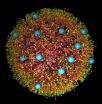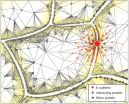Parasites and the evolution of primate culture
Study examines 'costs' of innovation, learning from others
2014-12-03
(Press-News.org) Learning from others and innovation have undoubtedly helped advance civilization. But these behaviours can carry costs as well as benefits. And a new study by an international team of evolutionary biologists sheds light on how one particular cost - increased exposure to parasites - may affect cultural evolution in non-human primates.
The results, published Dec. 3, 2014, in the journal Proceedings of the Royal Society B, suggest that species with members that learn from others suffer from a wider variety of socially transmitted parasites, while innovative, exploratory species suffer from a wider variety of parasites transmitted through the environment, such as in the soil or water.
"We tend to focus on innovation and learning from others as a good thing, but their costs have received relatively little attention," says McGill University biologist Simon Reader, co-author of the study. "Here, we uncover evidence that socially transmitted pathogen burdens rise with learning from others - perhaps because close interaction is needed for such learning - and environmentally transmitted pathogen burdens rise with exploratory behaviour such as innovation and extractive foraging."
Chimpanzees, for example, live in groups and have a wide range of such behaviours, such as digging for food underground or eating new kinds of insects. Previously, studies have not been able to determine whether costly parasites force primates to engage in more exploratory behaviour - by diversifying food sources, for example - or whether exploratory behaviour leads to their having more parasites, Reader notes. "Our results support the idea that exploratory and social behaviours expose primates to specific kinds of parasites."
"The findings also lead to questions about how people and other primates have developed solutions to minimize these parasite costs - such as eating medicinal plants - and may help us better understand how the processes underlying human culture arose," Reader says.
The research team, led by Collin McCabe of Harvard University and Charles Nunn of Duke University, based their analyses on databases obtained by surveying thousands of articles on primate behaviour and parasites.
INFORMATION:
Funding for the research was provided by the National Science Foundation, the Natural Sciences and Engineering Research Council of Canada, and the Netherlands Organisation for Scientific Research.
McCabe, C. M., Reader, S. M. & Nunn, C. L. 2015. Infectious disease, behavioural flexibility, and the evolution of culture in primates. Proceedings of the Royal Society B, 282: 20140862. Published online 3 December 2014.
DOI: 10.1098/rspb.2014.0862
http://rspb.royalsocietypublishing.org/content/282/1799/20140862
ELSE PRESS RELEASES FROM THIS DATE:
2014-12-03
This news release is available in German.
(Jena/Germany) Jena scientists have been successful in producing highly specific nanoparticles. Depending on the bound dye the particles are guided to the liver or to the kidney and deliver their payload of active ingredients directly to the targeted tissue. Moreover, the dyes enable the tracking of the transport processes by intravital microscopy or, in a non-invasive way, by multi spectral optoacoustic tomography. The reduction of cholesterol production induced by siRNA served as the proof-of-principle for the developed ...
2014-12-03
What do lasers, neural networks, and spreading epidemics have in common? They share a most basic feature whereby an initial pulse can propagate through a medium - be it physical, biological or socio-economic, respectively. The challenge is to gain a better understanding - and eventually control - of such systems, allowing them to be applied, for instance to real neural systems. This is the objective of a new theoretical study published in EPJ B by Clemens Bachmair and Eckehard Schöll from the Berlin University of Technology in Germany. Ultimately, with a better theoretical ...
2014-12-03
New research from the University of Adelaide has helped to shed light on the complexities of child sleep, and could lead to improved diagnosis of children with sleep-related breathing problems.
For his PhD in the University's School of Medical Sciences, Scott Coussens has been investigating how to accurately measure the level of sleep disturbance being experienced by children, to show whether or not they require treatment.
"Quality sleep is extremely important for children, especially at critical times of development. It can impact on the health of the brain and plays ...
2014-12-03
New Rochelle, NY, December 3, 2014--Are adolescents who view pornography or music videos more likely to engage in sexting, in which they share sexually explicit content via text, photo, or video using cell phones, email, or social networking sites? A study of the media consumption and sexting behavior of more than 300 teens is published in Cyberpsychology, Behavior, and Social Networking, a peer-reviewed journal from Mary Ann Liebert, Inc., publishers. The article is available free on the Cyberpsychology, Behavior, and Social Networking website.
In "The Associations ...
2014-12-03
Plastic waste is one of today's major environmental concerns. Most types of plastic do not biodegrade but break up into ever smaller pieces while remaining a polymer. Also, most types are made from oil, a rapidly dwindling resource. But there are promising alternatives, and one of them is polylactic acid (PLA): it is biodegradable and made from renewable resources. Manufacturers use PLA for disposable cups, bags and other sorts of packaging. The demand for PLA is constantly rising and has been estimated to reach about one megaton per year by 2020.
The research groups ...
2014-12-03
Planets orbiting close to low-mass stars -- easily the most common stars in the universe -- are prime targets in the search for extraterrestrial life.
But new research led by an astronomy graduate student at the University of Washington indicates some such planets may have long since lost their chance at hosting life because of intense heat during their formative years.
Low-mass stars, also called M dwarfs, are smaller than the Sun, and also much less luminous, so their habitable zone tends to be fairly close in. The habitable zone is that swath of space that is just ...
2014-12-03
People in the country's unhappiest communities spend about a quarter of the month so far down in the dumps that it can harm their productivity, according to economists.
"This is a real concern not just in the United States, but across the world," said Stephan Goetz, professor of agricultural economics and regional economics, Penn State, and director of the Northeast Regional Center for Rural Development. "Poor mental health can result in considerable economic costs, including losses of billions of dollars to lower productivity and this doesn't even include the staggering ...
2014-12-03
PHILADELPHIA--Quitting smoking sets off a series of changes in the brain that Penn Medicine researchers say may better identify smokers who will start smoking again--a prediction that goes above and beyond today's clinical or behavioral tools for assessing relapse risk.
Reporting in a new study published this week in the journal Neuropsychopharmacology, James Loughead, PhD, associate professor of Psychiatry, and Caryn Lerman, PhD, a professor of Psychiatry and director of Penn's Center for Interdisciplinary Research on Nicotine Addiction, found that smokers who relapsed ...
2014-12-03
Recent research from the Met Office and the University of East Anglia (UEA) suggests breaking the existing global and UK temperature records is much more likely due to human influence on the climate.
Early Figures Suggest Global Record Possible
The global mean temperature for January to October based on the HadCRUT4 dataset (compiled by the Met Office and UEA's Climatic Research Unit) is 0.57 °C (+/- 0.1) above the long-term (1961-1990) average. This is consistent with the statement from the World Meteorological Organization (WMO) today.
With two months of data still ...
2014-12-03
Researchers at the Mechanobiology Institute at the National University of Singapore have comprehensively described the network of proteins involved in cell-cell adhesions, or the cadherin interactome. This work was published in Science Signaling (Guo et al. E-cadherin interactome complexity and robustness resolved by quantitative proteomics, Science Signaling, 02 Dec 2014, Vol 7, Issue 354).
Unlocking the complexity of cell adhesion
Many biological processes depend on the ability of cells to stick to one another. The formation of multicellular organisms and precise ...
LAST 30 PRESS RELEASES:
[Press-News.org] Parasites and the evolution of primate culture
Study examines 'costs' of innovation, learning from others




